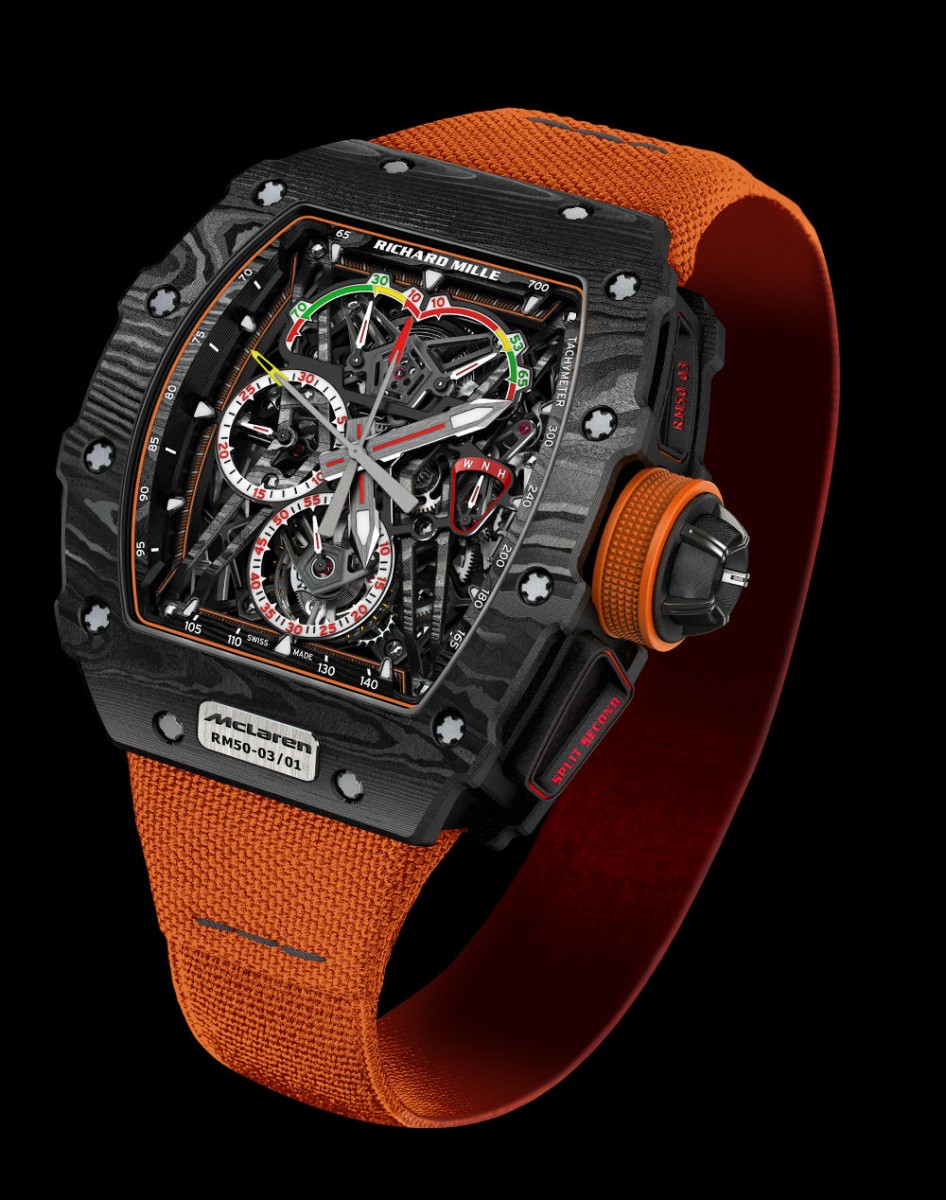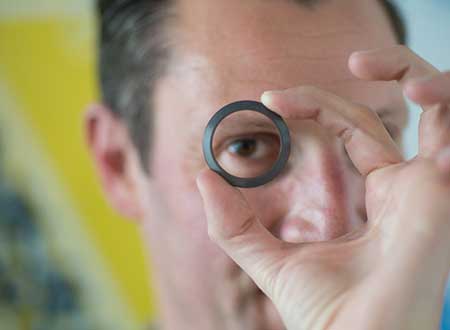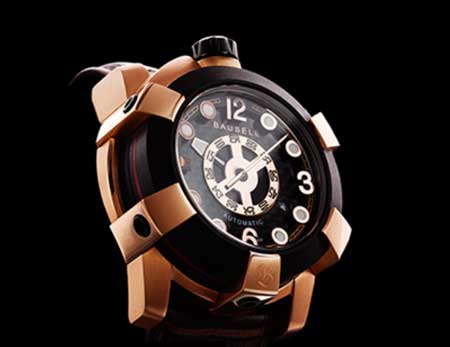This latest watch from the Richard Mille company by way of the University of Manchester isn’t the lightest watch the company has ever made but it is their lightest, most complex watch yet at less than 1.5 oz. It also has a breathtaking price tag. More about that later.
An August 29, 2018 news item on Nanowerk announces the publication of research related to the graphene-enhanced watch,
In January 2017 the world’s lightest mechanical chronograph watch was unveiled in Geneva, Switzerland, showcasing innovative composite development by using graphene. Now the research behind the project has been published. The unique precision-engineered watch was a result of collaboration between The University of Manchester [UK], Richard Mille Watches and McLaren Applied Technologies.
An August 29, 2018 University of Manchester press release, which originated the news item, gives further detail,
The RM 50-03 watch was made using a unique composite incorporating graphene to manufacture a strong but lightweight new case to house the watch mechanism which weighed just 40 grams in total, including the strap.
The collaboration was an exercise in engineering excellence, exploring the methods of correctly aligning graphene within a composite to make the most of the two-dimensional materials superlative properties of mechanical stiffness and strength whilst negating the need for the addition of other, weightier materials.
Now the research behind this unique watch has been published in the journal, Composites Part A: Applied Science and Manufacturing. The work was primarily carried out by a group of researchers at The University of Manchester’s National Graphene Institute.
Leading the research Professor Robert Young said: “In this work, through the addition of only a small amount of graphene into the matrix, the mechanical properties of a unidirectionally-reinforced carbon fibre composite have been significantly enhanced.
“This could have future impact on precision-engineering industries where strength, stiffness and product weight are key concerns such in as aerospace and automotive.”
The small amount of graphene used was added to a carbon fibre composite with the goal of improving stiffness and reducing weight by requiring the use of less overall material. Since graphene has high levels of stiffness and strength, its use as a reinforcement
in polymer composites shows huge potential of further enhancing the mechanical properties of composites.
The final results were achieved with only a 2% weight fraction of graphene added to the epoxy resin. The resulting composite with graphene and carbon fibre was then analysed by tensile testing and the mechanisms were revealed primarily by using Raman spectroscopy and X-ray CT scans.
The benefits of this research demonstrate a simple method which can be incorporated into existing industrial processes, allowing for engineering industries to benefit from graphene mechanical properties, such as the manufacture of airplane wings or the body work of high-performance cars.
The research group discovered that when comparing with a carbon fibre equivalent specimen, the addition of graphene significantly improved the tensile stiffness and strength. This occurred when the graphene was dispersed through the material and aligned in in the fibre direction.
Dr Zheling Li, a University of Manchester Research Associate said: “This study presents a way of increasing the axial stiffness and strength of composites by simple conventional processing methods, and clarifying the mechanisms that lead to this reinforcement.”
Aurèle Vuilleumier R&D Manager at Richard Mille said: “This project is a perfect example of technology transfer from the university to the product. The partnership with McLaren Applied Technologies allows a broad diffusion of graphene-enhanced composites in the industry. As a tangible result, a world record light and strong watch was available for our customers: the RM 50-03.”
Dr Broderick Coburn, Senior Mechanical Design Engineer at McLaren Applied Technologies said: “The potential of graphene to enhance composites’ structural properties has been known and demonstrated at a lab-scale for some time now. This application, although niche, is a great example of those structural benefits making it through to a prepreg material, and then into an actual product.”
The University of Manchester will soon be celebrating the opening of its second world-class graphene facility, the Graphene Engineering Innovation Centre (GEIC), set-to open later this year. The GEIC will allow industry to work alongside academic expertise to translate research into prototypes and pilot production and accelerate the commercialisation of graphene.
Here’s a link to and a citation for the paper,
Realizing the theoretical stiffness of graphene in composites through confinement between carbon fibers by Jingwen Chu, Robert J.Young, Thomas J.A.Slater, Timothy L.Burnett, Broderick Coburn, Ludovic Chichignoud, Aurèle Vuilleumier, Zheling Li. Composites Part A: Applied Science and Manufacturing Volume 113, October 2018, Pages 311-317 DOI: https://doi.org/10.1016/j.compositesa.2018.07.032
This paper is open access.
Price tag?
There’s an old saying, ‘if you have to ask, you can’t afford it’. It sprang to mind as I checked out the luxury Swiss watch company’s, Richard MIlle, products. You won’t find a price tag on the company’s RM 50-03’s product page but you will get lots of pictures of the watch mixed in with sports car images alongside chunks of text exhorting the watch and invoking sports car racing, a very expensive sport. And, the sports car images make even more sense when you know that the one of other partners in this academic/commercial venture is a UK leader in the field of motorsport. More from the About page on the McLaren website,
Whatever we apply ourselves to at McLaren, whether in the fields of racing, supercars or technology; we are committed to a journey of relentless improvement that challenges convention, disrupts markets and delivers powerful competitive advantage.
I was not able to find a price list on the Mille or McLaren sites. In fact, the watch does not seem to be mentioned at all on the McLaren website.
Happily, there’s a January 17, 2017 posting by Zach Pina for A Blog To Watch, which kind of reveals the price (Note: Links have been removed),
Forty grams [less than 1.5 oz.]. That’s the total weight, including the strap, of the new Richard Mille RM 50-03 McLaren F1 watch, making it the lightest split-second chronograph with a tourbillon the world has ever seen. Ok, yes – this isn’t exactly an ultra-competitive category – hell, the RM 50-03 is a veritable boat-anchor when compared to the groundbreaking 19-gram [less that .75 oz.] RM 027 Tourbillon Richard Mille built for Rafael Nadal, but that was, by comparison, a much less complicated watch. A mere 40 grams is still an impressive technical feat when you look at just how much is packed into the latest marvel from Richard Mille. The cost for the 40-gram horological wonder? It’ll be seven figures. [The blog post’s title has the price as $1Million.]
Sports cars are expensive and, I guess, so is the technology when it’s adapted to watches. If you’re at all interested, watches, luxury products, and/or the latest high technology, I recommend reading Pina’s entire posting for a lively read,
Richard Mille is no slouch when it comes to passionately creative design and materials (possible understatement of the year, though the year [2017] is still young). However, in breaking new ground for this particular watch, it took a partnership between the Swiss watchmaker, famed British Formula 1 automaker McLaren, and Nobel Prize-winning scientists from the University of Manchester. The product of their collaboration is a case that marries titanium, carbon TPT (thin-ply technology), and a Richard Mille exclusive and apparent watchmaking first: Graph TPT, better known as graphene, that is six times lighter than steel and 200 times as strong. It’s on the cutting edge of materials research and sets the bar for lightweight strength in timepieces.
Should you be hoping for a bargain, I don’t expect they’ve dropped the price in an effort to move product as it reaches its second anniversary since part of the appeal of a luxury product is the cost. In fact, luxury brands destroy product rather than lower the price,
Since media have started reporting on this practice, it seems luxury brands are reconsidering their practices.

![Courtesy: Bausele [downloaded http://www.thefashionisto.com/dominic-purcell-2016-bausele-campaign/]](http://www.frogheart.ca/wp-content/uploads/2016/12/DominicPurcellBausele-.jpg)

